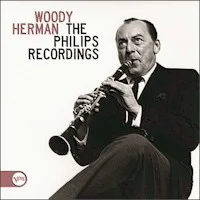A fine swing clarinetist, an altoist whose sound was influenced by Johnny Hodges, a good soprano saxophonist, and a spirited blues vocalist, Woody Herman's greatest significance to jazz was as the leader of a long line of big bands. He always encouraged young talent and, more than practically any bandleader from the swing era, kept his repertoire quite modern. Although Herman was always stuck performing a few of his older hits (he played "Four Brothers" and "Early Autumn" nightly for nearly 40 years), he much preferred to play and create new music.
Woody Herman began performing as a child, singing in vaudeville. He started playing saxophone when he was 11, and four years later he was a professional musician. He picked up early experience playing with the big bands of Tom Gerun, Harry Sosnik, and Gus Arnheim, and then in 1934, he joined the Isham Jones orchestra. He recorded often with Jones, and when the veteran bandleader decided to break up his orchestra in 1936, Herman formed one of his own out of the remaining nucleus. The great majority of the early Herman recordings feature the bandleader as a ballad vocalist, but it was the instrumentals that caught on, leading to his group being known as "the Band That Plays the Blues." Woody Herman's theme "At the Woodchopper's Ball" became his first hit (1939). Herman's early group was actually a minor outfit with a Dixieland feel to many of the looser pieces and fine vocals contributed by Mary Ann McCall, in addition to Herman. They recorded very frequently for Decca, and for a period had the female trumpeter/singer Billie Rogers as one of its main attractions.
Woody Herman returned to emphasizing straight-ahead jazz by the late '70s. By then, he was being hounded by the IRS due to an incompetent manager from the 1960s not paying thousands of dollars of taxes out of the sidemen's salaries. Herman, who might very well have taken it easy, was forced to keep on touring and working constantly into his old age. He managed to put on a cheerful face to the public, celebrating his 50th anniversary as a bandleader in 1986. However, his health was starting to fail, and he gradually delegated most of his duties to Frank Tiberi before his death in 1987. Tiberi continued to lead a Woody Herman Orchestra on a part-time basis but it never had the opportunity to record. Fortunately, Herman was well documented throughout all phases of his career, and his major contributions are still greatly appreciated. ~ Scott Yanow
Woody Herman began performing as a child, singing in vaudeville. He started playing saxophone when he was 11, and four years later he was a professional musician. He picked up early experience playing with the big bands of Tom Gerun, Harry Sosnik, and Gus Arnheim, and then in 1934, he joined the Isham Jones orchestra. He recorded often with Jones, and when the veteran bandleader decided to break up his orchestra in 1936, Herman formed one of his own out of the remaining nucleus. The great majority of the early Herman recordings feature the bandleader as a ballad vocalist, but it was the instrumentals that caught on, leading to his group being known as "the Band That Plays the Blues." Woody Herman's theme "At the Woodchopper's Ball" became his first hit (1939). Herman's early group was actually a minor outfit with a Dixieland feel to many of the looser pieces and fine vocals contributed by Mary Ann McCall, in addition to Herman. They recorded very frequently for Decca, and for a period had the female trumpeter/singer Billie Rogers as one of its main attractions.
Woody Herman returned to emphasizing straight-ahead jazz by the late '70s. By then, he was being hounded by the IRS due to an incompetent manager from the 1960s not paying thousands of dollars of taxes out of the sidemen's salaries. Herman, who might very well have taken it easy, was forced to keep on touring and working constantly into his old age. He managed to put on a cheerful face to the public, celebrating his 50th anniversary as a bandleader in 1986. However, his health was starting to fail, and he gradually delegated most of his duties to Frank Tiberi before his death in 1987. Tiberi continued to lead a Woody Herman Orchestra on a part-time basis but it never had the opportunity to record. Fortunately, Herman was well documented throughout all phases of his career, and his major contributions are still greatly appreciated. ~ Scott Yanow
Album: The Philips Recordings (Disc 1)
Bitrate: MP3@320K/s
Time: 76:20
Size: 174.8 MB
Styles: Big band
Year: 2011
Art: Front
[6:43] 1. Mo-Lasses
[3:29] 2. Blues For J.P
[4:17] 3. Don't Get Around Much Anymore
[4:16] 4. Tunin' In
[3:26] 5. Sister Sadie
[3:49] 6. Sig Ep
[3:05] 7. It's A Lonesome Old Town (When You're Not Around)
[8:15] 8. Camel Walk
[2:54] 9. Moon River
[3:23] 10. Hallelujah Time
[3:48] 11. Deep Purple
[4:37] 12. Jazz Hoot
[3:13] 13. A Taste Of Honey
[3:18] 14. Satin Doll
[5:13] 15. After You've Gone
[3:08] 16. The Strut
[3:29] 17. My Wish
[5:49] 18. Cousins
The Philips Recordings (Disc 1) mc
The Philips Recordings (Disc 1) zippy
Album: The Philips Recordings (Disc 2)
Bitrate: MP3@320K/s
Time: 60:13
Size: 137.9 MB
Styles: Big band
Year: 2011
Art: Front
[4:00] 1. That's Where It Is
[5:41] 2. Watermelon Man
[4:55] 3. Body And Soul
[5:29] 4. Better Get It In Your Soul
[2:57] 5. Jazz Me Blues
[4:49] 6. El Toro Grande
[3:22] 7. Days Of Wine And Roses
[7:46] 8. Caldonia
[3:20] 9. Wailin' In The Woodshed
[2:30] 10. The Good Earth
[2:47] 11. Sidewalks Of Cuba
[3:49] 12. I Can't Get Started
[3:37] 13. Bijou
[5:05] 14. Apple Honey
The Philips Recordings (Disc 2) mc
The Philips Recordings (Disc 2) zippy





